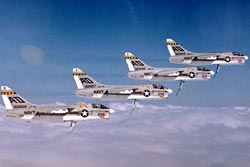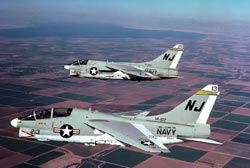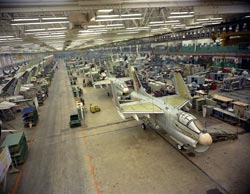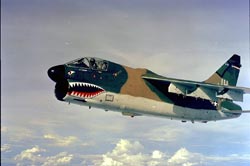|
 The LTV A-7 Corsair II was one of the most successful military aircraft of modern times and probably the greatest bargain in weapon system procurement history. The taxpayer certainly got his money’s worth and the naval aviator was provided an efficient vehicle for operational training and a superior weapon for combat. A-7A's cost a little over one million dollars each and delivered weapons with an accuracy unheard of in their day, while achieving the lowest loss rate of any aircraft in the Vietnam war. Later A-7 models went on to pioneer sophisticated avionics systems which are the norm today. The head-up display, the central navigation-weapon delivery computer and many other avionics innovations were first used on the A-7. The life of the A-7 covers several periods. The A-7A, B and C were basically the same airplane with engine updates and other system modifications related to the engine. The A-7D and A-7E were giant steps into the future, with sophisticated avionics suites which set the pattern for all future weapon delivery and navigation systems. The LTV A-7 Corsair II was one of the most successful military aircraft of modern times and probably the greatest bargain in weapon system procurement history. The taxpayer certainly got his money’s worth and the naval aviator was provided an efficient vehicle for operational training and a superior weapon for combat. A-7A's cost a little over one million dollars each and delivered weapons with an accuracy unheard of in their day, while achieving the lowest loss rate of any aircraft in the Vietnam war. Later A-7 models went on to pioneer sophisticated avionics systems which are the norm today. The head-up display, the central navigation-weapon delivery computer and many other avionics innovations were first used on the A-7. The life of the A-7 covers several periods. The A-7A, B and C were basically the same airplane with engine updates and other system modifications related to the engine. The A-7D and A-7E were giant steps into the future, with sophisticated avionics suites which set the pattern for all future weapon delivery and navigation systems.  The next phase was a series of two-place designs, encompassing the U.S. Navy TA-7C, U.S. Air Force A-7K, Greek TA-7H and Portuguese TA-7P. Then came the low-altitude night attack (LANA) version of the A-7D and A-7K. Finally, there came a major propulsion upgrade which took the A-7 into the supersonic performance range as the U.S. Air Force YA-7F. The A-7A first flew in September 1965,and the first operational U.S. Navy squadron airplane was delivered in October 1966. An incredible first-flight-to-first-delivery record! The Navy entered combat with the A-7A in December 1967. The U.S. Navy flew its final A-7E combat missions during the Gulf War in 1990, and the A-7D's and A-7K's were retired from active service in 1993, with final operations still being conducted by Air National Guard units. The A-7, in all of its variants, had a remarkable record of success in flight operations and in combat. A truly successful airplane. The next phase was a series of two-place designs, encompassing the U.S. Navy TA-7C, U.S. Air Force A-7K, Greek TA-7H and Portuguese TA-7P. Then came the low-altitude night attack (LANA) version of the A-7D and A-7K. Finally, there came a major propulsion upgrade which took the A-7 into the supersonic performance range as the U.S. Air Force YA-7F. The A-7A first flew in September 1965,and the first operational U.S. Navy squadron airplane was delivered in October 1966. An incredible first-flight-to-first-delivery record! The Navy entered combat with the A-7A in December 1967. The U.S. Navy flew its final A-7E combat missions during the Gulf War in 1990, and the A-7D's and A-7K's were retired from active service in 1993, with final operations still being conducted by Air National Guard units. The A-7, in all of its variants, had a remarkable record of success in flight operations and in combat. A truly successful airplane.
 A total of 1,545 airframes were manufactured, and of these 113 were remanufactured to produce additional models of the airplane. This included 60 TA-7C's, 44 A-7B's, 6 TA-7P's and 2 YA-7F's. Though seldom publicized, it racked up accomplishments of startling proportions. In over 5 million flight hours between 1968 and 1991, U.S. Air Force and U.S. Navy A-7's were the U.S. military's most cost-effective aerial weapon. It was noted for capability to carry very heavy weapon loads (up to 20,000 pounds), ultra low maintenance requirements (9 to 11 maintenance man hours per flight hour), superior weapon delivery accuracy (bombing within 50 meters of friendly troops), long range ( up to 4,250 nautical miles), low loss rate in combat (0.04%), and very low accident rate. It was also an airplane that was easy to fly and that was well liked by the pilots. A total of 1,545 airframes were manufactured, and of these 113 were remanufactured to produce additional models of the airplane. This included 60 TA-7C's, 44 A-7B's, 6 TA-7P's and 2 YA-7F's. Though seldom publicized, it racked up accomplishments of startling proportions. In over 5 million flight hours between 1968 and 1991, U.S. Air Force and U.S. Navy A-7's were the U.S. military's most cost-effective aerial weapon. It was noted for capability to carry very heavy weapon loads (up to 20,000 pounds), ultra low maintenance requirements (9 to 11 maintenance man hours per flight hour), superior weapon delivery accuracy (bombing within 50 meters of friendly troops), long range ( up to 4,250 nautical miles), low loss rate in combat (0.04%), and very low accident rate. It was also an airplane that was easy to fly and that was well liked by the pilots.
 Unfortunately, DOD's desire for multi-role supersonic fighter/attack aircraft with stealth capabilities spelled doom for the A-7 and for low-cost combat aircraft in general. The day of the single-purpose combat aircraft that cost under $5M gave way to the $50M fighter/attack machine, at least in the United States. However, this trusty workhorse will be around for many years as an international warplane because of the incredible punch it can deliver at a very low price. The A-7's in storage at Davis-Monthan Air Force Base in Tucson, Arizona are fast disappearing and soon will be no more. It is sad sight to see such a marvelous piece of machinery, still fully capable, regulated to the scrap heap. However, thanks to our program support to our allies around the globe, A-7's are still in service in Portugal, Greece, and Thailand. Like the DC-3, the A-7 is likely to be around many decades in the future. Unfortunately, DOD's desire for multi-role supersonic fighter/attack aircraft with stealth capabilities spelled doom for the A-7 and for low-cost combat aircraft in general. The day of the single-purpose combat aircraft that cost under $5M gave way to the $50M fighter/attack machine, at least in the United States. However, this trusty workhorse will be around for many years as an international warplane because of the incredible punch it can deliver at a very low price. The A-7's in storage at Davis-Monthan Air Force Base in Tucson, Arizona are fast disappearing and soon will be no more. It is sad sight to see such a marvelous piece of machinery, still fully capable, regulated to the scrap heap. However, thanks to our program support to our allies around the globe, A-7's are still in service in Portugal, Greece, and Thailand. Like the DC-3, the A-7 is likely to be around many decades in the future.
A-7:
Genesis of the Navy Attack Bomber, Light (VA(L))
In Comat
Farewell Proud Bird
Aircraft Performance Perspective
The Effect of the A-7 Gun
Will WE Make the Guarantee?
|